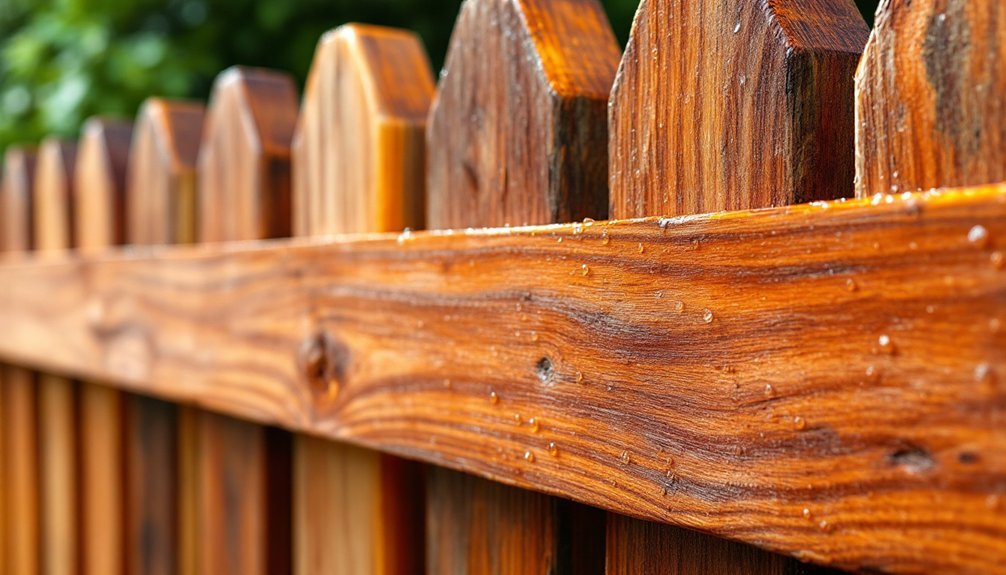Your cedar fence represents a significant investment in your property's beauty and security, but without proper protection, it can quickly deteriorate from weather damage and pests. You're faced with countless wood preservative options, many containing harsh chemicals that harm the environment while others simply don't work as advertised. In this 2025 guide, we'll explore five cedar oil preservatives that truly deliver on their promises, combining natural protection with lasting results for your outdoor structures.
Garden Box Sealer, Food-Safe Wood Sealant for Raised Beds
Gardeners who prioritize food safety will find Garden Box Sealer to be an ideal solution for preserving wooden raised beds. This FDA Food Contact Safe sealant uses plant-based oils that penetrate deeply into wood fibers, protecting your garden boxes for a decade or more.
You'll appreciate that it contains no toxic chemicals that could leach into your soil or harm your plants. It's effective on all wood types, preventing over 90% of cracks, warping, and splitting. While some users note a strong initial scent, the eco-friendly formula covers up to 100 square feet and works equally well for birdhouses and chicken coops.
Best For: Home gardeners who want a non-toxic, long-lasting sealant for their wooden raised beds, planters, and pet enclosures that won't contaminate soil or harm plants.
Pros:
- FDA Food Contact Safe formula with plant-based ingredients ensures no toxic chemicals leach into garden soil or harm vegetables
- Deeply penetrates wood fibers to prevent cracking, warping, and splitting for 10+ years of protection
- Versatile application methods (brush or sprayer) with coverage of up to 100 square feet per container
Cons:
- Strong initial scent that some users find unpleasant and may linger for several days after application
- Limited transparency regarding complete ingredient list for those with specific sensitivities
- May require annual reapplication to maintain optimal appearance and protection in certain climates
Rust-Oleum Wolman CopperCoat Green Wood Preservative (1904A)
Homeowners concerned with long-term protection for outdoor wood structures will find Rust-Oleum's Wolman CopperCoat Green Wood Preservative an industrial-strength solution. This EPA-registered product defends against termites, wood-boring insects, rot, and decay fungi.
You'll get ideal results applying it to untreated or pressure-treated wood in below-ground, ground-contact, and freshwater installations. It's particularly effective for protecting end cuts on pressure-treated lumber.
With coverage of 30-100 square feet per quart, you can easily treat fence posts, docks, landscape timbers, and other moisture-exposed wood. Just remember to wear protective gear due to strong fumes during application.
Best For: Homeowners and DIY enthusiasts seeking to protect untreated or pressure-treated wood structures in high-moisture environments like docks, fence posts, and landscape timbers from insect damage and decay.
Pros:
- EPA-registered formula provides industrial-strength protection against termites, wood-boring insects, and fungi
- Versatile application methods (dip, brush, or roller) with coverage of 30-100 square feet per quart
- Particularly effective for pressure-treated wood end cuts, extending the life of outdoor wooden structures
Cons:
- Emits strong fumes during application, requiring proper protective gear and ventilation
- Some users report inconsistent long-term effectiveness against mold and decay
- Green tint may not be aesthetically pleasing for all wood applications
Cedar Oil by Giles and Kendall (8 oz)
Cedar Oil by Giles and Kendall (8 oz) stands out as an exceptional choice for anyone seeking to revitalize aging cedar surfaces while naturally deterring insects. This 100% natural product effectively restores the original aroma of your cedar wood panels and prolongs their lifespan.
You'll appreciate how a small amount covers approximately 300 square feet, making it economical despite its premium pricing. For best results, lightly sand your cedar before applying with a damp cloth. Customers particularly love the authentic redwood forest scent that lingers after application.
It's also versatile enough for use on non-cedar woods to repel moths and silverfish from closets and furniture.
Best For: Homeowners with aging cedar closets, chests, or furniture who want to restore the natural aroma while protecting their wood from insects naturally.
Pros:
- 100% natural oil extracted from Aromatic Eastern Redcedar that effectively rejuvenates the scent and extends the life of cedar surfaces
- Economical coverage with 8 oz treating approximately 300 square feet of cedar wood
- Versatile application that works on both cedar and non-cedar woods to naturally repel moths, silverfish, and other insects
Cons:
- Packaging can be difficult to open, with some customers reporting needing tools to access the product
- Premium price point compared to other wood treatments, though many users find the quality justifies the cost
- Scent longevity varies by application and environment, with some customers noting it fades faster than expected
Cedarcide Cedarshield Non-Toxic Wood Treatment and Stabilizer (1 Gallon)
Environmentally conscious wood enthusiasts seeking a non-toxic alternative to chemical preservatives will find Cedarcide Cedarshield an exceptional solution. This gallon-sized treatment protects up to 200 square feet of any wood type, creating an effective barrier against moisture, grease, and acids.
You'll appreciate its versatility on fences, decks, garden boxes, and outdoor furniture. With impressive longevity of up to 8 years between applications and a quick 72-hour drying time, it offers convenience alongside protection. While most users praise its pleasant cedar scent and termite-repelling properties, be aware that some have reported water penetration issues. At 7.09 pounds, it's a substantial investment in your wood's future.
Best For: Environmentally conscious homeowners seeking a long-lasting, non-toxic wood treatment for outdoor structures and furniture who don't mind paying a premium for natural protection.
Pros:
- Creates a moisture-resistant barrier that protects wood from water, grease, acids, and other damaging elements for up to 8 years
- Compatible with all wood types including hard, soft, new, and old wood, making it versatile for various outdoor applications
- Non-toxic formulation offers an eco-friendly alternative to chemical-based wood preservatives with a pleasant cedar scent
Cons:
- Some users have reported issues with water penetration and discoloration after application despite moisture-resistance claims
- Coverage of only 200 square feet per gallon may require multiple containers for larger projects, increasing overall cost
- Three-day drying time is considerably longer than many competing wood treatment products
Dr. Killigan's CedarWard Spray – Natural Cedar Oil Formula (4 fl. oz.)
For those seeking a natural alternative to chemical mothballs, Dr. Killigan's CedarWard Spray offers a solution with its Virginia cedarwood oil formula. You'll find this 4 fl. oz. spray rejuvenates cedar products and helps repel moths and silverfish.
The application is straightforward—spray directly on cedar items or use a cloth for precision. While effective, the scent divides users, with many noting strong vanilla notes overshadowing the cedar aroma. The 20% cedar oil formula lasts several days, though effectiveness against pests varies.
Some customers question ingredients like sodium benzoate despite its eco-friendly marketing.
Best For: Those seeking an eco-friendlier alternative to chemical mothballs who want to rejuvenate cedar products and protect clothing and linens from moths and silverfish.
Pros:
- Contains 20% natural cedar oil that helps repel pests like moths and silverfish from closets and storage areas
- Easy application with spray bottle design allows for direct use on cedar products or application via cloth
- Creates a pleasant woodsy scent in storage spaces without the harmful chemicals found in traditional mothballs
Cons:
- The scent includes prominent vanilla notes that some users find inauthentic compared to pure cedar
- Contains ingredients like sodium benzoate and sodium lauryl sulfate that some consumers seeking natural products prefer to avoid
- Fragrance may fade within a few days, potentially requiring frequent reapplication for continued effectiveness
Factors to Consider When Choosing the Most Effective Cedar Oil Wood Preservative for Natural Fence Protection
When selecting a cedar oil wood preservative for your natural fence, you'll need to weigh food-safe formulations against chemical alternatives based on your property's specific needs. Your fence's wood type considerably impacts which preservative will perform best, as cedar, pine, and hardwoods each respond differently to various oil formulations. Consider also the application method, expected longevity, maintenance requirements, and environmental impact to guarantee you're making the most sustainable and effective choice for your outdoor space.
Food-Safe vs. Chemical Options
While protecting your cedar fence remains the primary goal, the choice between food-safe and chemical preservatives carries significant implications for your health, garden, and environment. Natural, plant-based cedar oil products offer peace of mind if you're growing food near your fence, as they won't leach toxic substances into soil.
Chemical preservatives deliver robust protection against insects and decay but may introduce harmful compounds that could affect your family, pets, and local ecosystem. Despite this tradeoff, you'll find that many food-safe options derived from natural oils match the longevity of chemical alternatives, often lasting 10+ years.
For garden applications, especially where children play or vegetables grow, natural cedar oil preservatives provide the ideal balance of effectiveness and safety without compromising on long-term protection.
Wood Type Compatibility
Three key factors determine how effectively cedar oil preservatives perform across different wood species in your fence preservation project. First, consider the wood's porosity—cedar oil works exceptionally well on both softwoods like pine and hardwoods such as oak and cherry, making it incredibly versatile for mixed-wood fences.
Second, evaluate your fence's age and condition. Older, previously untreated wood often shows remarkable improvement after cedar oil application, while newer installations benefit from preventative protection. You'll see particularly impressive results when treating cedar fencing with cedar oil, as it enhances the wood's natural insect and moisture resistance.
Finally, preparation matters greatly. For ideal absorption, lightly sand weathered surfaces and apply to slightly damp wood, allowing the oil to penetrate deeply regardless of wood type.
Application Method Differences
Four distinct application techniques dramatically impact your cedar oil preservative's effectiveness on fence protection projects. Spraying offers quick, even coverage for large fence sections, making it ideal for time-sensitive projects. You'll achieve more precision with brush application, allowing better control in detailed areas, though it requires more time and effort.
Dipping provides the most thorough saturation but isn't practical for already-installed fences or large structures. It's best reserved for smaller components during construction. Roller application strikes a balance between spraying and brushing—it's faster than a brush while giving you more control than spraying.
Your choice affects not just application efficiency but also penetration depth and protection longevity. Consider your project size, time constraints, and desired results when selecting the method that will best preserve your fence.
Longevity and Maintenance Needs
After selecting your application method, understanding the longevity and maintenance requirements becomes your next priority when choosing cedar oil preservatives. Product lifespans vary dramatically—some formulations protect for up to 8 years, while others demand annual reapplication to maintain effectiveness.
Consider your fence's size when evaluating coverage claims. Products treat anywhere from 30 to 300 square feet per application, greatly impacting maintenance frequency and overall cost-effectiveness.
Environmental conditions play an essential role in preservative performance. Fences exposed to harsh weather, high moisture, or extreme temperature fluctuations will require more frequent maintenance than those in moderate climates.
Look for fast-drying formulations that cure within 72 hours to minimize project disruption. Remember to schedule regular inspections regardless of claimed longevity, as protection against moisture and decay naturally diminishes over time.
Environmental Impact Considerations
When selecting cedar oil preservatives for your fence, environmental impact should rank among your top priorities. Traditional wood preservatives often contain harsh chemicals that leach into surrounding soil, potentially harming your garden and local ecosystem. Instead, look for eco-friendly options that utilize natural ingredients while still providing effective protection.
Choose products specifically labeled as FDA Food Contact Safe if you're treating structures near vegetable gardens or food plants. These meet rigorous safety standards that prevent toxic residue contamination. Plant-based sealants offer additional benefits through their biodegradability and lower carbon footprint compared to chemical alternatives.
Pay attention to VOC content in any preservative you're considering. Products with minimal or zero volatile organic compounds improve air quality during application and throughout the product's lifespan, reducing your environmental footprint while protecting your cedar fence.
Frequently Asked Questions
How Often Should Cedar Oil Preservatives Be Reapplied?
You should reapply cedar oil preservatives every 1-2 years. If your fence is exposed to harsh weather conditions or shows signs of fading, you'll need more frequent applications to maintain protection.
Can Cedar Oil Products Be Used on Pressure-Treated Wood?
Yes, you can apply cedar oil products on pressure-treated wood. It's best to wait 3-6 months after installation for the treatment to weather first. Cedar oil provides additional protection and enhances the wood's appearance.
Will Cedar Oil Preservatives Change My Fence's Natural Color?
Yes, cedar oil preservatives will slightly darken your fence's natural color. They'll enhance the wood grain and give it a richer, amber tone while providing protection. You'll notice the difference immediately after application.
Are Cedar Oil Preservatives Effective Against Termites?
Yes, cedar oil preservatives are effective against termites. They're a natural repellent that disrupts termites' nervous systems and masks wood scents. You'll get good protection when applied correctly and maintained regularly.
Can Cedar Oil Wood Preservatives Be Applied in Cold Weather?
You shouldn't apply cedar oil preservatives in cold weather. They work best when temperatures are above 50°F. Cold conditions prevent proper absorption and extend drying time, reducing the treatment's effectiveness on your wood.





Leave a Reply